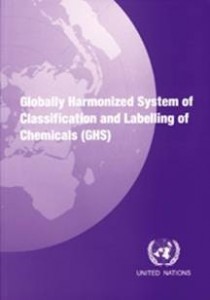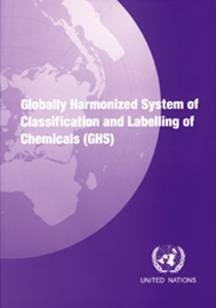
What is the GHS?
In a matter of months, companies that use, manufacture, or distribute hazardous chemicals are expected to have trained employees on the new Globally Harmonized System (GHS) that provides universal criteria for classifying and labeling hazardous chemicals.
Since GHS has been a work-in-progress ever since the UN Conference on Environment and Development in 1992, we’re posting a brief refresher on GHS and how to transition to the GHS system.
GHS was developed to standardize the criteria for and labeling of hazardous chemicals on a global scale. Under GHS, information about the physical, environmental, and health hazards of chemicals are communicated on customized chemical labels that are understandable within in any country, regardless of that country’s unique language or culture.
In the U.S., the Occupational Safety and Health Administration (OSHA) has created a new Hazard Communications Standard (HCS) that complies with GHS regulations. Major changes from the previous Hazard Communications Standard include mandatory hazard research and classification of all chemicals manufactured or imported, a standard label that can be customized to label all hazardous chemicals, a new Safety Data Sheet (SDS) template to be completed for each hazardous chemical, and new training requirements for employees who will be reading GHS labels and Safety Data Sheets.
When should I start using it?
OSHA advises chemical users and producers who will be expected to transition to the new GHS system in the next few years. Chemical users should prepare for the transition by rewriting Safety Data Sheets and updating their hazard communications programs if necessary. Chemical users should also train employees to read the new label elements (next week’s post will provide detailed information on the new GHS labels).
Chemical producers should stay up-to-date on hazard information for all chemicals they make or import and update those chemicals’ classifications according to the new GHS criteria. Chemical producers should also rewrite safety data sheets and create new GHS compliant labels. As you can see from OSHA’s timeline below, compliance with all GHS standards will be expected within the next few years.
| Effective Completion Date | Requirement(s) | Who |
| December 1, 2013 | Train employees on the new label elements and SDS format. | Employers |
| June 1, 2015* December 1, 2015 |
Comply with all modified provisions of this final rule, except: Distributors may ship products labeled by manufacturers under the old system until December 1, 2015. |
Chemical manufacturers, importers, distributors and employers |
| June 1, 2016 | Update alternative workplace labeling and hazard communication program as necessary, and provide additional employee training for newly identified physical or health hazards. | Employers |
| Transition Period | Comply with 29 CFR 1910.1200 (this final standard), the current standard, or both. | All chemical manufacturers, importers, distributors and employers. |
*This date coincides with the European Union implementation date for classification of mixture
Source: OSHA’s Hazard Communication
Why is it better than what we use now?
OSHA says that the benefits of GHS will be great and potentially save producers millions of dollars. They say that, among other things, GHS will protect human health and the environment, provide a hazardous chemical classification system for countries that have not already established a system, simplify international trade, and avoid the extra time and resources used to translate from one chemical classification system to another.
If you have any questions or comments about the Globally Harmonized System, please contact us!
